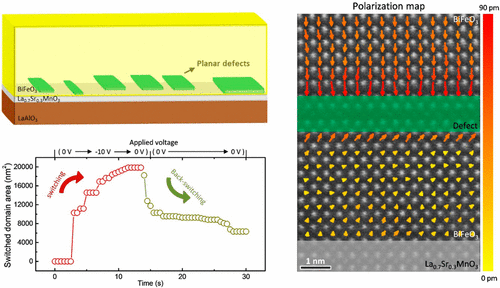当前位置:
X-MOL 学术
›
Nano Lett.
›
论文详情
Our official English website, www.x-mol.net, welcomes your
feedback! (Note: you will need to create a separate account there.)
Atomic-Scale Mechanisms of Defect-Induced Retention Failure in Ferroelectrics
Nano Letters ( IF 9.6 ) Pub Date : 2017-05-04 00:00:00 , DOI: 10.1021/acs.nanolett.7b00696 Linze Li,Yi Zhang,Lin Xie,Jacob R. Jokisaari,Christianne Beekman,Jan-Chi Yang,Ying-Hao Chu,Hans M. Christen,Xiaoqing Pan
Nano Letters ( IF 9.6 ) Pub Date : 2017-05-04 00:00:00 , DOI: 10.1021/acs.nanolett.7b00696 Linze Li,Yi Zhang,Lin Xie,Jacob R. Jokisaari,Christianne Beekman,Jan-Chi Yang,Ying-Hao Chu,Hans M. Christen,Xiaoqing Pan

|
The ability to switch the ferroelectric polarization using an electric field makes ferroelectrics attractive for application in nanodevices such as high-density memories. One of the major challenges impeding this application, however, has been known as “retention failure”, which is a spontaneous process of polarization back-switching that can lead to data loss. This process is generally thought to be caused by the domain instability arising from interface boundary conditions and countered by defects, which can pin the domain wall and impede the back-switching. Here, using in situ transmission electron microscopy and atomic-scale scanning transmission electron microscopy, we show that the polarization retention failure can be induced by commonly observed nanoscale impurity defects in BiFeO3 thin films. The interaction between polarization and the defects can also lead to the stabilization of novel functional nanodomains with mixed-phase structures and head-to-head polarization configurations. Thus, defect engineering provides a new route for tuning properties of ferroelectric nanosystems.
中文翻译:

铁电中缺陷诱导的保留失效的原子尺度机理
利用电场来切换铁电极化的能力使得铁电对于在诸如高密度存储器的纳米器件中的应用具有吸引力。然而,阻碍该应用的主要挑战之一被称为“保留失败”,这是极化反向切换的自发过程,可能导致数据丢失。通常认为此过程是由界面边界条件引起的域不稳定性引起的,并被缺陷所抵消,这些缺陷会固定域壁并阻碍反向切换。在这里,使用原位透射电子显微镜和原子级扫描透射电子显微镜,我们表明,BiFeO 3中通常观察到的纳米级杂质缺陷可导致偏振保持失败。薄膜。极化和缺陷之间的相互作用还可以导致具有混合相结构和头对头极化构型的新型功能性纳米域的稳定化。因此,缺陷工程为调节铁电纳米系统的性能提供了一条新途径。
更新日期:2017-05-12
中文翻译:

铁电中缺陷诱导的保留失效的原子尺度机理
利用电场来切换铁电极化的能力使得铁电对于在诸如高密度存储器的纳米器件中的应用具有吸引力。然而,阻碍该应用的主要挑战之一被称为“保留失败”,这是极化反向切换的自发过程,可能导致数据丢失。通常认为此过程是由界面边界条件引起的域不稳定性引起的,并被缺陷所抵消,这些缺陷会固定域壁并阻碍反向切换。在这里,使用原位透射电子显微镜和原子级扫描透射电子显微镜,我们表明,BiFeO 3中通常观察到的纳米级杂质缺陷可导致偏振保持失败。薄膜。极化和缺陷之间的相互作用还可以导致具有混合相结构和头对头极化构型的新型功能性纳米域的稳定化。因此,缺陷工程为调节铁电纳米系统的性能提供了一条新途径。





















































 京公网安备 11010802027423号
京公网安备 11010802027423号